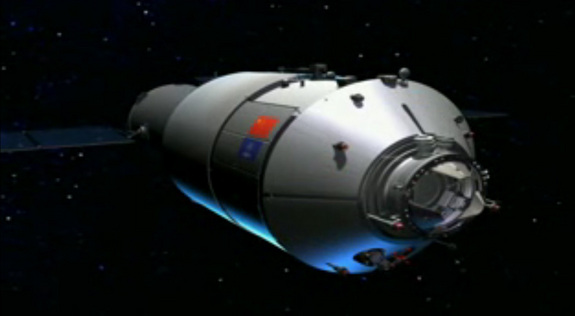Chinese Space Program 6 - History 6
In the fall of 2011, China launched its first space station, the Tiangong 1, aboard a Long March 2F/G rocket. It was launched into orbit without a crew. Its mission was to serve as manned laboratory and a test platform for orbital rendezvous. The Tiangong 1was remotely maneuver into different obits during its mission. The Tiangong 1 is intended to be the first in a series of three Tiangong space stations with the largest to be launched in 2023. The Tiangong is still in orbit today.
The Tiangong 1 weighs almost nineteen thousand pounds. The station is a cylinder, thirty four feet long and eleven feet in diameter. It consists of two modules; one for the solar panels and propulsion, the other for the laboratory and living quarters. There are two sleeping stations and exercise equipment onboard. The pressurized volume is a little over five hundred cubic feet. When a Shenzhou space capsule is docked with the station, toilets, cooking facilities and a third sleep station are provided in the capsule.
Shortly after the launch of the Tiangong 1 station, the unmanned Shenzhou 8 spacecraft was launched. It was remotely maneuvered into successfully docking and undocking three times with the Tiangong 1 to test the docking apparatus. The Shenzhou 8 was in orbit for sixteen days during the tests. The Shenzhou 8 was the last of the Shenzhou spacecraft to see significant modifications. The Chinese intend to use the finalized design for future manned missions.
In mid-2012, the Shenzhou 9 was launched with a crew of three on a Long March 2F Rocket. One of the astronauts was the first woman to be launched into space by China. The Shenzhou 9 was successfully docked via remote control from the ground with the Tiangong 1 station. After pressure was equalized between the spacecraft and the station, the crew moved into the Tiangong 1. During the six day mission, one member of the crew slept in the Shenzhou 9. During the mission, the crew of the spacecraft successfully undocked and docked the Shenzhou manually. After the mission was completed, the Shenzhou 9 undocking and returned successfully to Earth in Mongolia.
In mid-2013, the Shenzhou 10 was launched with a crew of three on a Long March 2F Rocket. It rendezvoused with the Tiangong 1 and the crew spent fourteen days conducting physical, technological, and scientific experiments including research in space medicine. One of the astronauts taught a physics class to Chinese students via a live television transmission. The Shenzhou 10 undocked and returned successfully to Earth. The Shenzhou 10 mission was the last in the first phase of the Tiangong 1 mission.
Tiangong 1:
